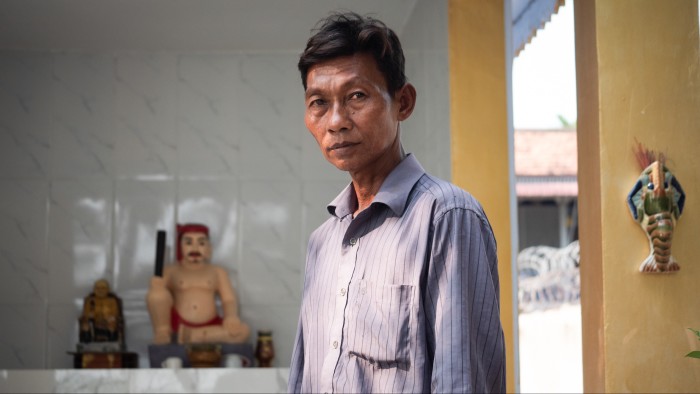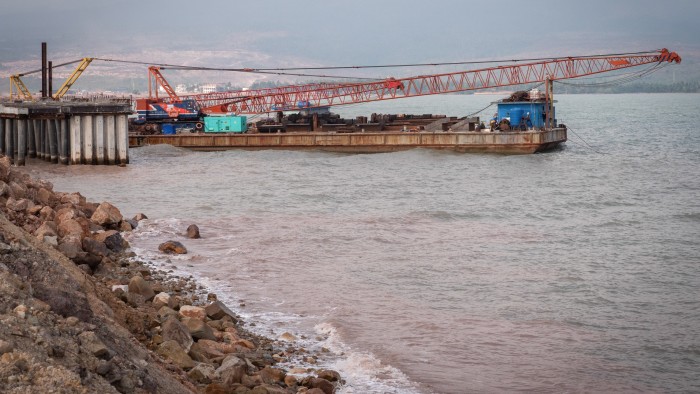Cambodia vexes Vietnam with plan to divert Mekong trade via China-built canal

Roula Khalaf, Editor of the FT, selects her favourite stories in this weekly newsletter.
From his house in Prek Takeo on the banks of the Mekong river, an hour’s drive from Phnom Penh, Cambodia, Mao Sarin can watch ships laden with containers chug by on their way to Vietnam and the river’s giant delta.
If the government of newly installed Cambodian Prime Minister Hun Manet follows through on plans, future shipments could travel along a $1.7bn, Chinese-funded canal — a project that would eliminate Mao Sarin’s tin-roofed home. The Funan Techo canal would directly connect Phnom Penh with Cambodian ports along the Gulf of Thailand, bypassing Vietnam’s traditional hold on the mouth of one of Asia’s biggest waterways.
“I have seen the development team come here to take measurements almost 20 times,” said Mao Sarin, a motorcycle-taxi driver and former soldier who has lived beside the river for more than three decades. “We are waiting in suspense.”
So is Hanoi. Vietnam has formally raised alarm over the canal’s potential effect on the Mekong Delta in the absence of a publicly available environmental impact assessment. The controversy also reflects deeper geopolitical tensions as Cambodia attempts to shift away from dependence on Vietnamese-controlled trade routes, undermining Hanoi’s regional leverage while further elevating Beijing’s influence in the southern Mekong.

This article is from Nikkei Asia, a global publication with a uniquely Asian perspective on politics, the economy, business and international affairs. Our own correspondents and outside commentators from around the world share their views on Asia, while our Asia300 section provides in-depth coverage of 300 of the biggest and fastest-growing listed companies from 11 economies outside Japan.
Cambodia’s economic interests remain tightly intertwined with Vietnam, which considers the kingdom a “special strategic partner.” Vietnam is Cambodia’s second-largest trade partner behind China, and trade between the two neighbours exceeded $6bn in 2023. Yet the canal could become a faultline between the two countries amid increasing regional polarity.
Chhengpor Aun, a research fellow at the Cambodian think-tank Future Forum, described the canal as the fulfilment of a “national imagination” by addressing Cambodia’s deep psychic wound from the perceived loss of the entire Mekong Delta when the area was formally merged with Vietnam under French colonial rule in 1949.
The canal’s nickname derives from the ancient Funan kingdom which extended across southern Vietnam and is seen in Cambodia as a precursor of the Khmer empire. Officially, the canal is known as the Tonle Bassac Navigation Road and Logistics System Project.
The grand Cambodian plans show the 100-metre-wide, two-lane canal, projected to begin operating in 2028, tracing a path from the banks of the Mekong just downstream from the Phnom Penh Autonomous Port, before cutting across to the Bassac river and continuing for 180km to the south-west coastal province of Kep.
Cambodia’s transport minister Peng Ponea has claimed the project will break ground this year, even though a feasibility study launched in October last year by the canal’s developer, state-owned China Road and Bridge Corporation, is not yet complete.

In Kep province, at the canal’s projected end point along a boardwalk overlooking a group of local fishermen, there is little indication of the ambitious plans under way. These would service a long-standing deep seaport inside Kampot’s sleepy cow pasture and rice field-filled special economic zone.
Down the road, an unmarked stretch of dirt protrudes into the sea, bustling with trucks filling in land for a $1.5bn port under construction since May 2022 by Kampot Logistics and Port. Last year China Harbour Engineering, a subsidiary of CBRC, signed a contract to help build the port.
Cambodian officials and business leaders have framed the canal as part of a broader logistics overhaul to reduce shipping costs by as much as 30 per cent, helping make the kingdom more competitive in key export sectors such as the garment industry.
But as Center for Southeast Asia Studies researcher Sothearak Sok has noted, there is an underlying rhetoric of reclaiming sovereignty — what Hun Manet has described as “breathing through our own nose”.
Hanoi raised environmental concerns over the canal with Hun Manet during his first state visit in December, a few months after he succeeded his father Hun Sen following the strongman’s nearly 40 years in power. A top Cambodian official told local media that the visit included the presentation of “the results of a number of studies” confirming “no impact on the environment”. The studies have not been made public.

In August last year, just as Hun Manet came into power, Cambodia notified the Mekong River Commission Secretariat, a regional oversight body, of plans to build a canal “on the tributary of the Mekong river” and said the impact would be limited to “dust in the air and noise” from construction.
However, Mekong expert Brian Eyler at the Washington-based Stimson Center think-tank said it was “undeniable” that the canal directly affected the Mekong mainstream based on the maps submitted to the MRC by Cambodian authorities. The impact would be far greater than those claimed by Cambodia, he added.
Under the 1995 Mekong Agreement, projects affecting the river’s mainstream are required to undergo “technical review” by the MRC, receiving input from member states including Vietnam, Laos and Thailand. The MRC Secretariat told Nikkei that it had “requested and been awaiting more information from Cambodia”.
Without sufficient precautions, the canal could disrupt natural flooding, increase salinity and alter water flows in the agricultural and economic engine of the Mekong Delta, which already faces severe environmental challenges, said Pham Dang Tri Van, a water resources researcher at Vietnam’s Can Tho University.

Cambodia’s summary of its environmental impact assessment provided to the MRC Secretariat states that the use of three locks along with the canal will ensure water discharge is “effectively controlled” to prevent significant changes to the Mekong’s flow.
There is little public information available as to how Cambodia plans to mitigate other impacts such as disruption of the Mekong Delta’s natural floodplains and evictions of people living along the canal’s route. Cambodian authorities referred Nikkei to their submission to the MRC Secretariat.
A Vietnamese foreign ministry spokesperson told Nikkei that Hanoi supported the socio-economic development of its neighbours but had asked Cambodia to share information regarding the project’s impact on the Mekong Delta “to ensure harmonious interests of riparian countries and local residents”.
Cambodia’s top government scientist Sok Touch, president of the Royal Academy, has implied that Vietnam’s real fear is a loss of control over Cambodia and that Hanoi should mind its own business.

“Look at Vietnam! They transport rice through a waterway system. Do you ever see them telling us [in advance] that they are going to dig that? No, they never tell us,” Sok Touch told state-aligned media in January.
A Nikkei analysis of social media and corporate records indicates that Kampot Logistics and Port, the Cambodian company working on Kampot’s deep-sea port, is controlled by tycoon Try Pheap, who is under restrictive US sanctions over alleged corruption and illegal logging.
While the tycoon is not listed as a director or owner of Kampot Logistics and Port, he stood in the front row at a construction contract-signing ceremony with the company’s Chinese developer last year. He has also previously acknowledged plans to build a deep-sea port in the area.
A representative for Try Pheap declined to comment.
Further up the coast from Kampot, the new canal would allow easy access to and from the Sihanoukville Special Economic Zone, a recipient of significant Chinese Belt and Road Initiative investment, and the Sihanoukville Autonomous Port, which handles the majority of Cambodia’s imports and exports.
Nearby is the controversial Ream naval base, which is receiving a Chinese-funded upgrade warily viewed by the US as evidence of its role as a future People’s Liberation Army facility, a prospect which Cambodia has repeatedly denied.
Some Vietnamese and American commentators have expressed concerns that the canal could be subject to use for military purposes by Beijing, though there is no indication this is the project’s intent.

The canal’s proponents argue it will be a faster and more cost-effective route than road or rail travel. However, ocean tankers arriving at Cambodia’s coastal ports would still need to offload their containers on to barges capable of carrying up to 1,000 tonnes up the 4.7-metre-deep canal in the rainy season from May to October, noted Cambodia Logistics Association president Sin Chanthy.
Nguyen Khac Giang, a Vietnamese research fellow at the Iseas-Yusof Ishak Institute in Singapore, said he did not believe Vietnam’s economy would be significantly affected by the canal “given the relatively small trade volumes involved” but argued it was “unwise to hastily advance such a major project without fully understanding its potential impacts”.
Other Vietnamese analysts have argued Hanoi retains leverage over Cambodia, pointing out that ships carrying more than 1,000 tonnes would still rely on Vietnamese ports to travel up the Mekong mainstream.
Hanoi has previously asserted its control of the southern Mekong Delta in clashes with Phnom Penh, including blocking ship traffic up the river for several months in 1994. In 2009 Cambodia and Vietnam signed a treaty allowing freedom of navigation along the Mekong.
For Cambodian researcher Chhengpor Aun, the canal would mean “Cambodia could reclaim a degree of economic — and even political — autonomy” from Vietnam, although the canal’s operation would remain in Beijing’s hands for more than five decades as part of its build-operate-transfer financing model.

At home, Hun Manet has defended the project’s price tag by telling the public that the government “did not borrow money from China to build the canal” and emphasising that the Chinese developer would assume the financial risk.
But with a downturn in the Chinese economy, observers such as Murray Hiebert, an analyst at the Center for Strategic and International Studies in Washington, have expressed doubts that the project will actually be built — at least on the ambitious timeframe envisioned by Phnom Penh.
“I don’t see how it [the canal] benefits China very much,” he said. “I can’t imagine they’re wanting to throw $1.7bn into this and build it in the next four years.”
CRBC and the Chinese embassy in Phnom Penh did not respond to requests for comment.
To build the canal the Hun Manet administration will have to “push [up against] the no-go line in bilateral relations with Vietnam”, said analyst Chhengpor Aun. “Walking between China and Vietnam is no easy task for Cambodia under new leadership. The path forward is getting more rocky and risky.”
For Mao Sarin and his neighbours living along the canal’s proposed route, the future is uncertain. He is not optimistic about receiving fair treatment, noting: “Where there’s development, there’s also unfair persecution.”
Additional reporting by Eung Sea
A version of this article was first published by Nikkei Asia on March 12. ©2024 Nikkei Inc. All rights reserved.
Comments